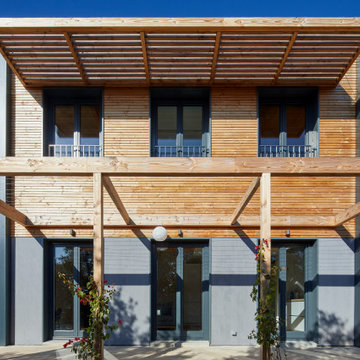110 ideas para fachadas multicolor nórdicas
Filtrar por
Presupuesto
Ordenar por:Popular hoy
21 - 40 de 110 fotos
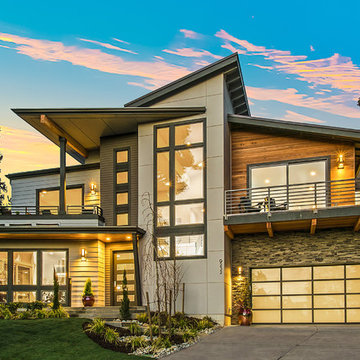
Photography by HD Estates
Architect/Designer | Dahlin Group Architecture Planning
Builder, Developer, and Land Planner | JayMarc Homes
Interior Designer | Aimee Upper
Landscape Architect/Designer | Art by Nature
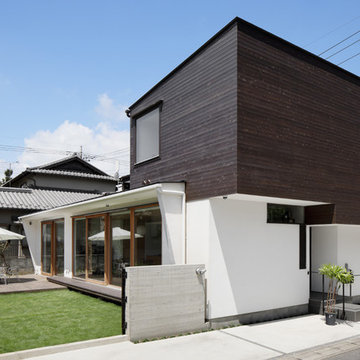
Modelo de fachada multicolor escandinava con tejado de un solo tendido
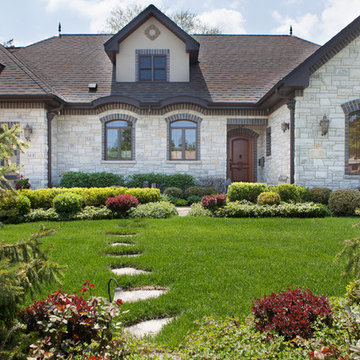
1,500 s.f. addition entails reconfiguring the first floor to accommodate a larger open kitchen plan, additional garage space, and an additional hall bath and changing the existing hall bath to additional space for the existing master bath. The northwest bedroom was converted to a walk in closet for the master suite. For the open plan to work the basement stair had to be relocated and an addition of a stair to the new second floor which accesses 2 additional bedrooms and a hall bath. The great room was upgraded with a vaulted ceiling and a masonry fireplace which contained an extra flue for an exterior fireplace from the rear patio.
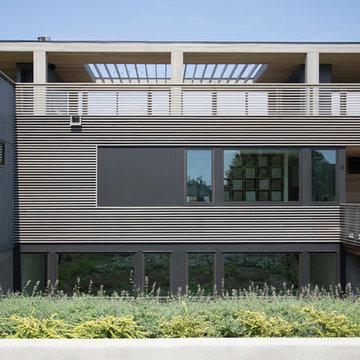
Photographer: © Resolution: 4 Architecture
Modelo de fachada de casa multicolor escandinava con revestimientos combinados y tejado plano
Modelo de fachada de casa multicolor escandinava con revestimientos combinados y tejado plano
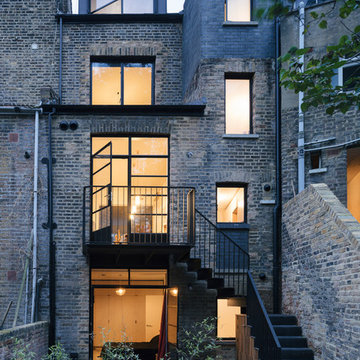
Architect: Tsuruta Architects
Client: Private
Photography: Tim Crocker
Imagen de fachada de casa pareada multicolor nórdica de tamaño medio de tres plantas con revestimiento de ladrillo, tejado plano y tejado de varios materiales
Imagen de fachada de casa pareada multicolor nórdica de tamaño medio de tres plantas con revestimiento de ladrillo, tejado plano y tejado de varios materiales
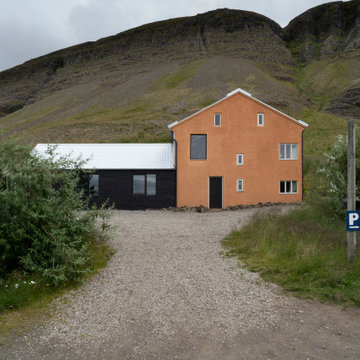
The Guesthouse Nýp at Skarðsströnd is situated on a former sheep farm overlooking the Breiðafjörður Nature Reserve in western Iceland. Originally constructed as a farmhouse in 1936, the building was deserted in the 1970s, slowly falling into disrepair before the new owners eventually began rebuilding in 2001. Since 2006, it has come to be known as a cultural hub of sorts, playing host to various exhibitions, lectures, courses and workshops.
The brief was to conceive a design that would make better use of the existing facilities, allowing for more multifunctional spaces for various cultural activities. This not only involved renovating the main house, but also rebuilding and enlarging the adjoining sheep-shed. Nýp’s first guests arrived in 2013 and where accommodated in two of the four bedrooms in the remodelled farmhouse. The reimagined sheep shed added a further three ensuite guestrooms with a separate entrance. This offers the owners greater flexibility, with the possibility of hosting larger events in the main house without disturbing guests. The new entrance hall and connection to the farmhouse has been given generous dimensions allowing it to double as an exhibition space.
The main house is divided vertically in two volumes with the original living quarters to the south and a barn for hay storage to the North. Bua inserted an additional floor into the barn to create a raised event space with a series of new openings capturing views to the mountains and the fjord. Driftwood, salvaged from a neighbouring beach, has been used as columns to support the new floor. Steel handrails, timber doors and beams have been salvaged from building sites in Reykjavik old town.
The ruins of concrete foundations have been repurposed to form a structured kitchen garden. A steel and polycarbonate structure has been bolted to the top of one concrete bay to create a tall greenhouse, also used by the client as an extra sitting room in the warmer months.
Staying true to Nýp’s ethos of sustainability and slow tourism, Studio Bua took a vernacular approach with a form based on local turf homes and a gradual renovation that focused on restoring and reinterpreting historical features while making full use of local labour, techniques and materials such as stone-turf retaining walls and tiles handmade from local clay.
Since the end of the 19th century, the combination of timber frame and corrugated metal cladding has been widespread throughout Iceland, replacing the traditional turf house. The prevailing wind comes down the valley from the north and east, and so it was decided to overclad the rear of the building and the new extension in corrugated aluzinc - one of the few materials proven to withstand the extreme weather.
In the 1930's concrete was the wonder material, even used as window frames in the case of Nýp farmhouse! The aggregate for the house is rather course with pebbles sourced from the beach below, giving it a special character. Where possible the original concrete walls have been retained and exposed, both internally and externally. The 'front' facades towards the access road and fjord have been repaired and given a thin silicate render (in the original colours) which allows the texture of the concrete to show through.
The project was developed and built in phases and on a modest budget. The site team was made up of local builders and craftsmen including the neighbouring farmer – who happened to own a cement truck. A specialist local mason restored the fragile concrete walls, none of which were reinforced.
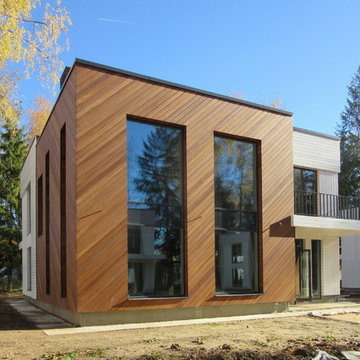
На фасадах сочетается 2 цвета дерева. Поселок окружен лесом
Modelo de fachada de casa multicolor nórdica de tamaño medio de dos plantas con revestimiento de madera, tejado plano y tejado de varios materiales
Modelo de fachada de casa multicolor nórdica de tamaño medio de dos plantas con revestimiento de madera, tejado plano y tejado de varios materiales
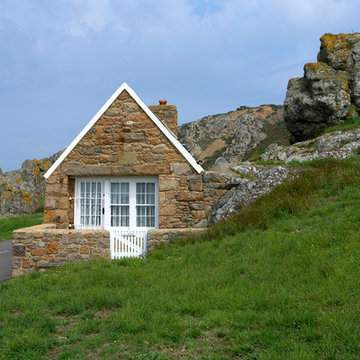
foto: Peter Baastrup - proffFOTO
Imagen de fachada multicolor escandinava pequeña de una planta con revestimiento de piedra y tejado a la holandesa
Imagen de fachada multicolor escandinava pequeña de una planta con revestimiento de piedra y tejado a la holandesa
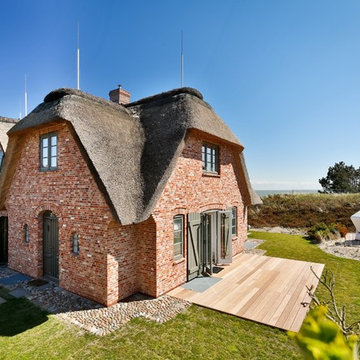
Diseño de fachada de casa multicolor nórdica grande de dos plantas con revestimiento de ladrillo y tejado a doble faldón
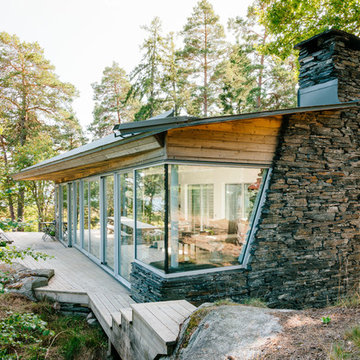
Diseño de fachada multicolor nórdica pequeña de una planta con revestimientos combinados
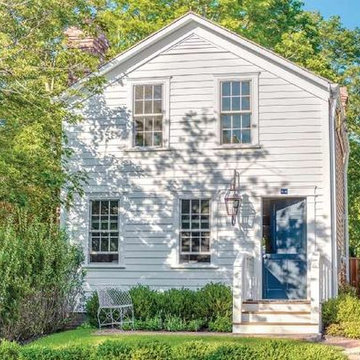
Foto de fachada de casa multicolor escandinava de tamaño medio de dos plantas con revestimiento de madera, tejado a dos aguas y tejado de teja de madera
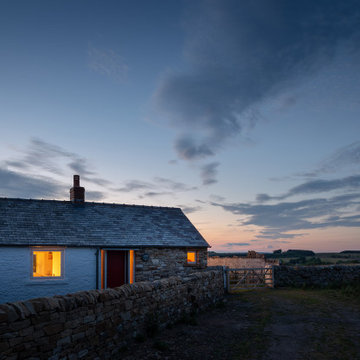
Diseño de fachada de casa bifamiliar multicolor nórdica pequeña a niveles con revestimiento de piedra, tejado a dos aguas y tejado de teja de barro
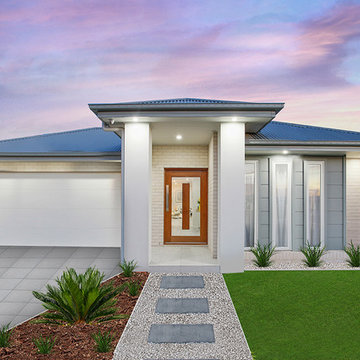
Home on display: The Amity
23 Silverthorne Street, Marsden Park, 2765
Home Consultants / Luke Swannell
0450 076 039
luke.swannell@adenbrook.com.au
Foto de fachada multicolor nórdica pequeña de una planta con revestimientos combinados y tejado a dos aguas
Foto de fachada multicolor nórdica pequeña de una planta con revestimientos combinados y tejado a dos aguas
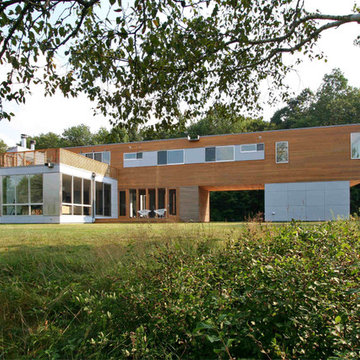
Photographer: © Resolution: 4 Architecture
Imagen de fachada de casa multicolor escandinava de dos plantas con revestimientos combinados y tejado plano
Imagen de fachada de casa multicolor escandinava de dos plantas con revestimientos combinados y tejado plano
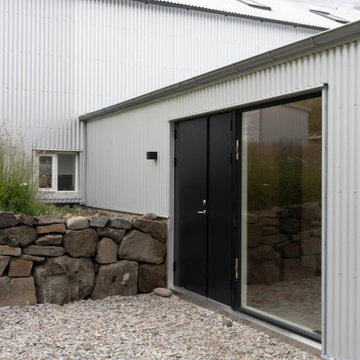
The Guesthouse Nýp at Skarðsströnd is situated on a former sheep farm overlooking the Breiðafjörður Nature Reserve in western Iceland. Originally constructed as a farmhouse in 1936, the building was deserted in the 1970s, slowly falling into disrepair before the new owners eventually began rebuilding in 2001. Since 2006, it has come to be known as a cultural hub of sorts, playing host to various exhibitions, lectures, courses and workshops.
The brief was to conceive a design that would make better use of the existing facilities, allowing for more multifunctional spaces for various cultural activities. This not only involved renovating the main house, but also rebuilding and enlarging the adjoining sheep-shed. Nýp’s first guests arrived in 2013 and where accommodated in two of the four bedrooms in the remodelled farmhouse. The reimagined sheep shed added a further three ensuite guestrooms with a separate entrance. This offers the owners greater flexibility, with the possibility of hosting larger events in the main house without disturbing guests. The new entrance hall and connection to the farmhouse has been given generous dimensions allowing it to double as an exhibition space.
The main house is divided vertically in two volumes with the original living quarters to the south and a barn for hay storage to the North. Bua inserted an additional floor into the barn to create a raised event space with a series of new openings capturing views to the mountains and the fjord. Driftwood, salvaged from a neighbouring beach, has been used as columns to support the new floor. Steel handrails, timber doors and beams have been salvaged from building sites in Reykjavik old town.
The ruins of concrete foundations have been repurposed to form a structured kitchen garden. A steel and polycarbonate structure has been bolted to the top of one concrete bay to create a tall greenhouse, also used by the client as an extra sitting room in the warmer months.
Staying true to Nýp’s ethos of sustainability and slow tourism, Studio Bua took a vernacular approach with a form based on local turf homes and a gradual renovation that focused on restoring and reinterpreting historical features while making full use of local labour, techniques and materials such as stone-turf retaining walls and tiles handmade from local clay.
Since the end of the 19th century, the combination of timber frame and corrugated metal cladding has been widespread throughout Iceland, replacing the traditional turf house. The prevailing wind comes down the valley from the north and east, and so it was decided to overclad the rear of the building and the new extension in corrugated aluzinc - one of the few materials proven to withstand the extreme weather.
In the 1930's concrete was the wonder material, even used as window frames in the case of Nýp farmhouse! The aggregate for the house is rather course with pebbles sourced from the beach below, giving it a special character. Where possible the original concrete walls have been retained and exposed, both internally and externally. The 'front' facades towards the access road and fjord have been repaired and given a thin silicate render (in the original colours) which allows the texture of the concrete to show through.
The project was developed and built in phases and on a modest budget. The site team was made up of local builders and craftsmen including the neighbouring farmer – who happened to own a cement truck. A specialist local mason restored the fragile concrete walls, none of which were reinforced.
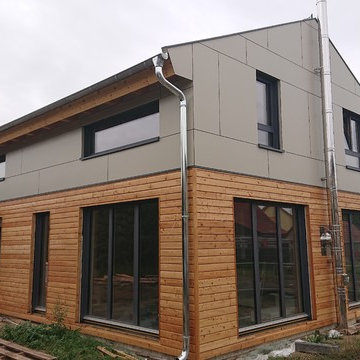
Imagen de fachada de casa multicolor nórdica de dos plantas con revestimientos combinados y tejado a dos aguas
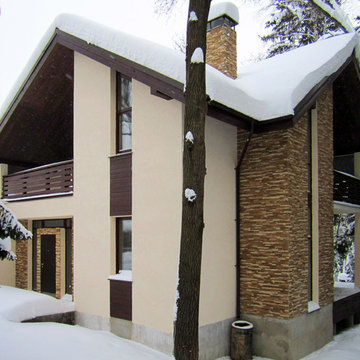
Архитектурное бюро Глушкова спроектировало дом для комфортного проживания в Подмосковье. Он не только тёплый и энергосберегающий, но и красивый с комбинированным фасадом.
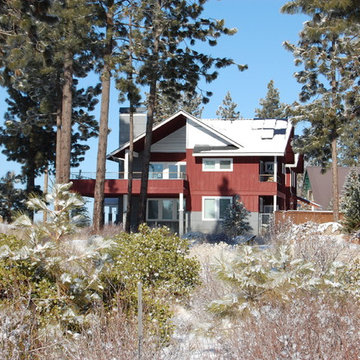
Imagen de fachada multicolor nórdica grande de dos plantas con revestimientos combinados y tejado a dos aguas
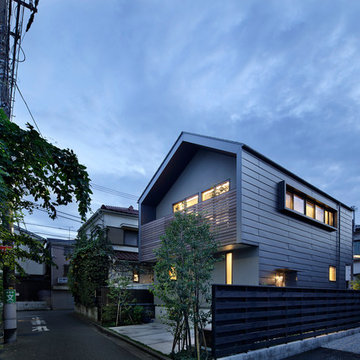
Photo Copyright Satoshi Shigeta
Imagen de fachada de casa multicolor nórdica pequeña de tres plantas con revestimiento de metal, tejado a dos aguas y tejado de metal
Imagen de fachada de casa multicolor nórdica pequeña de tres plantas con revestimiento de metal, tejado a dos aguas y tejado de metal
110 ideas para fachadas multicolor nórdicas
2
